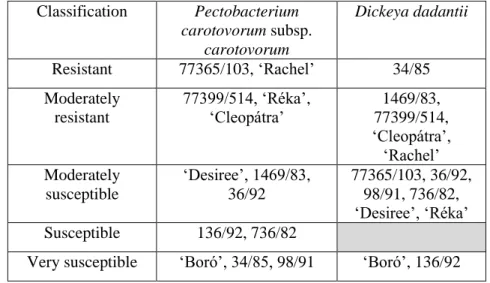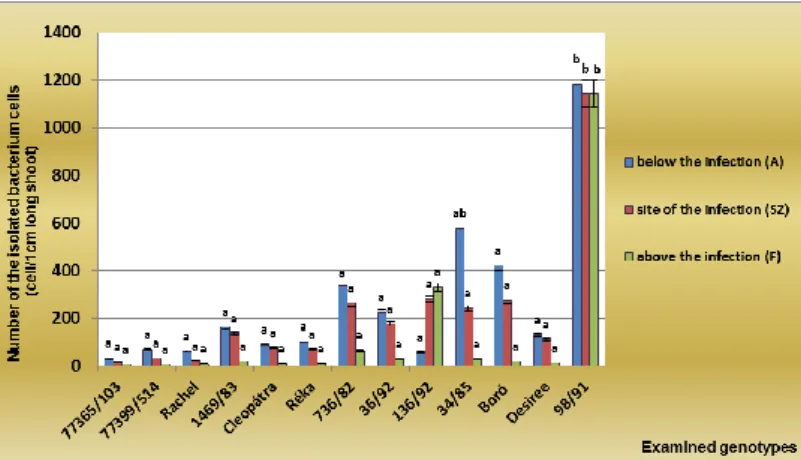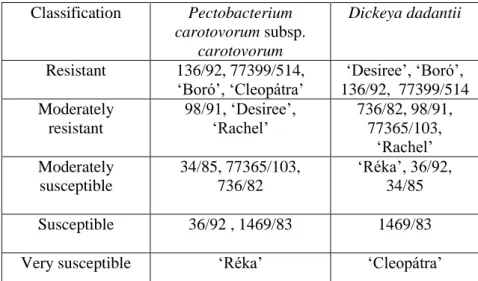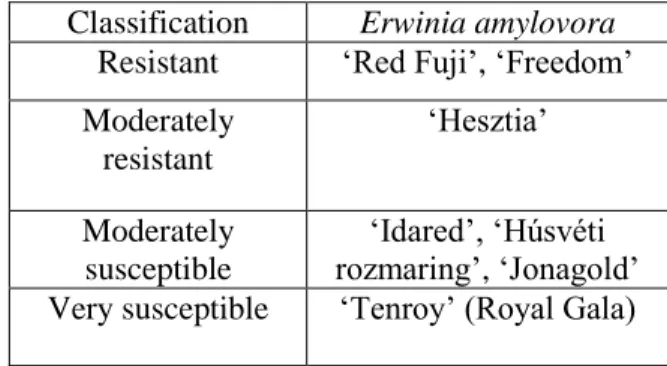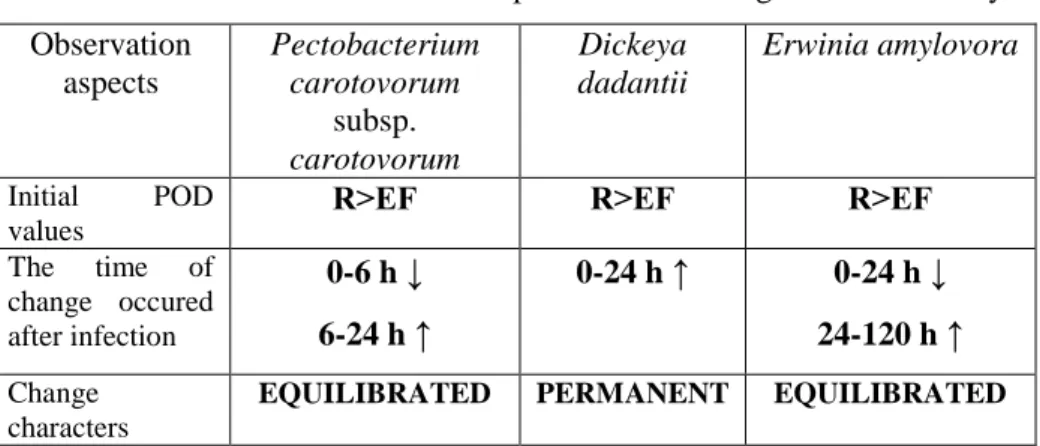Theses of PhD dissertation
SOFT ROT AND FIRE BLIGHT SUSCEPTIBILITY OF IN VITRO POTATO AND APPLE PLANTLETS
Ildikó Hudák
Supervisor: Dr. Magdolna Tóth, DSc
Associate supervisor: Dr. Mária Hevesi, CSc
Corvinus University of Budapest Department of Fruit Science
Budapest 2014
PhD School Name: Doctoral School of Horticultural Sciences
Field: Crop Sciences and Horticulture
Head of PhD School: Dr. Magdolna Tóth
Doctor of the Hungarian Academy Sciences Head of Department of Fruit Sciences Corvinus University of Budapest, Faculty of Horticultural Sciences
Supervisor: Dr. Magdolna Tóth
Doctor of the Hungarian Academy Sciences Head of Department of Fruit Sciences Corvinus University of Budapest, Faculty of Horticultural Sciences
Associate supervisor: Dr. Mária Hevesi Senior researcher, CSc
Corvinus University of Budapest, Faculty of Horticultural Sciences Department of Fruit Sciences
The applicant met the requirement of the PhD regulations of the Corvinus University of Budapest and the thesis is accepted for the defence process.
Dr. Magdolna Tóth Dr. Magdolna Tóth
Head of PhD School Supervisor
3
1. INTRODUCTION
Among biotic stress factors, the bacterial diseases including Erwinia species caused significant yield losses in Hungary in the last years.
Symptoms caused by different Erwinia species are completely different. Pectobacterium carotovorum subsp. carotovorum (syn.
Erwinia carotovora subsp. carotovora) and Dickeya dadantii (syn.
Erwinia chrysanthemi) are the bacterium species, which attack potato causing so called „soft-rot”. In contrast, Erwinia amylovora causes fire blight on infected apple.
They are widespread in the world and can cause significant economic losses worldwide. There is no effective protection method against to them yet. Involvement of resistant cultivars into agricultural production would be a solution.
Several contradicting results have been reported in the literature about biochemical changes induced by infection in in vitro conditions.
Therefore we considered to be important task to study the host- responses of plants to biotic stress including biochemical markers. Our aim was to clarify that responses of plants to different diseases are the same or different. These investigations required special conditions because biochemical changes can be tracked only on plants, which grow under the same conditions, such as in vitro plantlets.
2. THE AIMS OF RESEARCH WORK
Implementation of resistance-tests and biochemical analysis, and further development of test-methods were the mean objects of our PhD research work.
The following specific tasks were intended to solve:
1. Studying of susceptibility/resistance traits (deegre of biotic stress tolerance) of potato cultivars/clones and apple cultivars on micropropagated plants.
2. Selection of resistant, moderate suscepible and very susceptible cultivars/clones for biochemical model- experiments.
3. Tracking and comparing of biochemical process accompanying different bacterial symptoms (soft-rot, fire blight).
4. Revealing of congenialities or differences in plant responses to infection (defense mechanism) using biochemical markers.
5. Studying of suitability of micropropagated plantlets for susceptibility/resistance tests.
6. Working out rapid and reliable test methods applicable on micropropagated plantlets.
5
3. MATERIAL AND METHODS
3.1. Bacteria
Suspensions of virulent strains of the Pectobacterium carotovorum subsp. carotovorum (Pcc), Dickeya dadantii (Dd) and Erwinia amylovora (Ea) were used in our experiments in concentration of 108 cells ml-1.
3.2. Plant material
Plant material were micropropagated for the experiments in the Biotechnology Laboratory of Research Institute of Nyíregyháza belonging to the Debrecen University. Potato genotypes involved in experiments were following: 77365/103, 98/91, 136/92, 36/92, 34/85, 736/82, 1469/83, 77399/514, ʻDesiree’, ʻRéka’, ʻCleopátra’, ʻRachel’ és a ʻBoró’). Apple cultivars (ʻRed Fuji’, ʻFreedom’, ʻHúsvéti rozmaring’, ʻJonagold’, ʻHesztia’, ʻIdared’ és ʻTenroy’ (Royal Gala)) were also studied.
3.3. Test methods for infection and evaluation of symptoms
We developed a new method for in vitro infection of potato (shoot and tuber). In vivo potato infections were made by use of method reported earlier by Vlasov and Pereverzev (1989). Infection of in vitro apple shoots were made by method described by Hevesi et al. (2000).
Three-week-old potato plantlets were used for in vitro shoot infection of potato cultivars. Symptoms on leaves and stems were
observed at the 7th day after infection, and index of infection (Fi) was calculated from results according to the formula:
Σ [(N1 x 1) + (N2 x 2) + (N3 x 3) + (N4 x 4) + (N5 x 5)]
Fi = ---
Σ N
where: N1-5: number of diseased plants belonging to the given scale- degree .
Σ N: the number of total observed plants
According to the Fi value potato cultivars were classified as resistant (Fi), or moderately resistant, or moderately susceptible, or susceptible or very susceptible against to the given bacterium.
Samples for counting of bacterium cells were collected from the site of inoculation (SZ), from the part of stem above the inoculation (F) and from the part of stem below the inoculation (A). 1-1 cm long pieces of stem were excised from sample sites and three pieces of stem per genotype were used for initiation of bacterium culture. Bacterium cultures were incubated at 26 °C for 48 h and then colonies developed were counted.
Infection of potato microtuber was made by sterile injection needle dipped into bacterium suspension: tubers were pierced and then placed onto wet filter paper in Petri dish. Evaulation were made at the first, at the third and at the seventh days after infection.
7
Discs of potato tuber were used for infection of primer tubers, and the weight of discs was measured previously. After infection the discs were placed into Petri dishes and incubated at 26 °C for 24-26 h.
The next day, rotted plant tissue was removed by washing and the weight of remaining (healthy) plant tissue was measured. Differences between the weight of potato discs after and before of inoculation was the base for determination of the degree of susceptibility. Results were expressed as the rate of healthy tissue weight (%).
Inoculation of micropropagated apple shoots was made by scissors dipped into bacterium suspension; the second, fully developed leaves from the shoot tips were cutted in half. Susceptibility of in vitro apple shoots were evaulated at the second, at the fifth and at the eighth days after inoculation. The degree of the disease was determined on the browning rates of tissues on the cutted leaves, and on the other leaves, and shoots infected systemically.
3.4. Biochemical analysis
Genotypes for biochemical analysis were selected according to the results of in vitro plantlets infection as follows: in the case of Pectobacterium carotovorum subsp. carotovorum: 77365/103 (resistant), 36/92 (moderately susceptible), 98/91 (very susceptible). In the case of Dickeya dadantii: 34/85 (resistant), ʻRéka’ (moderately susceptible), ʻBoró’ (very susceptible). In the case of Erwinia
amylovora: ʻFreedom’ (resistant), ʻHúsvéti rozmaring’ (moderately susceptible), ʻTenroy’ (very susceptible).
Determination of peroxidase activity was performed in the Corvinus University of Budapest, Department of Applied Chemistry. The POD activity was measured by spectrophotometrical method in the presence of H2O2, as substrate and ortho-dianisidine as chromogenic reagent (ε=11,3) (Shannon et al., 1966). The increase of absorbance was measured at 460 nm. The enzyme activity was calculated on fresh weight and it was given in U/mg.
Determination of carbohydrate content was realized in the HPLC laboratory of the Department of Fruit Science belonging also to the Corvinus University of Budapest.
Statistical analysis of results were made by one-way ANOVA using SPSS 13.0 for Windows software. Homogenous groups were formed by Tukey-test.
4. RESULTS AND DISCUSSION
4.1. Susceptibilty of potato genotypes
Based on the results observed at 7th day after infection of in vitro potato shoots we can conclude that genotypes can be classified into four or five groups considering their susceptability for Pcc or Dd, respectively.
9
The majority of genotypes proved to be moderately resistant or moderately susceptible (Table 1).
Table 1. Susceptibilty of in vitro potato shoots to Pectobacterium carotovorum subsp. carotovorum and Dickeya dadantii.
Classification Pectobacterium carotovorum subsp.
carotovorum
Dickeya dadantii
Resistant 77365/103, ʻRachel’ 34/85 Moderately
resistant
77399/514, ʻRéka’, ʻCleopátra’
1469/83, 77399/514, ʻCleopátra’, ʻRachel’
Moderately susceptible
ʻDesiree’, 1469/83, 36/92
77365/103, 36/92, 98/91, 736/82, ʻDesiree’, ʻRéka’
Susceptible 136/92, 736/82
Very susceptible ʻBoró’, 34/85, 98/91 ʻBoró’, 136/92
In short, ʻRachel’ and 77365/103 proved to be resistant, while ʻBoró’, 34/85 and 98/91 proved to be the most susceptible to Pcc. Only 34/85 clones showed resistance against to Dd, while ʻBoró’ and the 136/92 werevery susceptible.
Comparing results obtained in experiments including in vitro potato plantlets, we can conclude that Pcc was more agressive and resulted in more severe symptoms than Dd. Some genotypes responded similarly to both bacteria as follows: 77399/514 and the ʻCleopátra’ were
moderately resistant, 36/92 and the ʻDesiree’ were moderately susceptible, while ʻBoró’ was very susceptible for both bacteria species.
Bacterial cell number of Pcc was determined on bacterium cultures isolated back from infected plant tissue at the 3rd and 7th day after infection, concomitantly with observations.
In the case of isolation made at the 3rd day the most bacteria colonies grown when isolation was made from the site of infection (SZ), and it was true for each tested genotype (Figure 1). Comparing potato genotypes the most bacterial colonies were observed on isolates originated from 98/91 including each sample site, and this result is accordance with results of shoot infection.
Figure 1.The number of cells of Pectobacterium carotovorum subsp. carotovorum isolated at the 3rd day after infection from in vitro potato shoots.
11
In contrast, when isolation was made at the 7th day after infection, the most bacterial colonies grown on cultures isolated from the sites below infection (A) (Figure 2).
Figure 2. The number of cells of Pectobacterium carotovorum subsp. carotovorum isolated at the 7th day after infection from in vitro potato shoots.
In the case of Dd the most bacteria colonies grown when isolation was made from the site of infection (SZ) either at the 3rd or 7th day.
However, similarly to Pcc, the number of bacterial cells isolated from the below infection (A) at the 7th day also showed an increase. These results suggest that infection spread in the stem downwards. Moreover, it seemed that multiplication and spreading of Dd in shoot is slower than that of Pcc. It can be supposed that it is the reason for the phenomen that symptoms of Dd on in vitro potato shoots were less severe than symptoms of Pcc.
Grouping of genotypes were based on the symptoms observed at the 7th day after infection of microtubers as listed in the Table 2.
Table 2. Susceptibility of in vitro potato tubers to Pectobacterium carotovorum subsp. carotovorum and Dickeya dadantii.
Classification Pectobacterium carotovorum subsp.
carotovorum
Dickeya dadantii
Resistant ʻRachel’ 77399/514
Moderately resistant
136/92, 34/85, 1469/83, 36/92, 736/82, ʻRéka’
Moderately susceptible
34/85, 1469/83, 36/92, 77399/514, 136/92, 736/82, 77365/103, ʻRéka’, ʻCleopátra’, ʻDesiree’ és a ʻBoró’
77365/103, 98/91, ʻCleopátra’, ʻDesiree’ és a ʻRachel’
Very susceptible 98/91 ʻBoró’
Comparing results obtained it is noticeable that some genotypes responded differently to infections by different bacteria species.
ʻRachel’ showed a good resistance against to Pcc, while it was moderately susceptible to Dd. In contrast, the 98/91 clone was very susceptible to Pcc but only moderately susceptible to Dd. Moreover, 77399/514 clone was resistant against to Dd and ʻBoró’ was the most susceptible to it, both of them were moderately susceptible to Pcc.
13
Classification results of susceptibility of potato primer tubers (Vlaslov és Pereverzev, 1989) are summarized in the Table 3.
Table 3. Susceptibility of tubers grown in greenhouse to Pectobacterium carotovorum subsp. carotovorum and Dickeya dadantii.
Classification Pectobacterium carotovorum subsp.
carotovorum
Dickeya dadantii
Resistant 136/92, 77399/514, ʻBoró’, ʻCleopátra’
ʻDesiree’, ʻBoró’, 136/92, 77399/514 Moderately
resistant
98/91, ʻDesiree’,
ʻRachel’ 736/82, 98/91, 77365/103,
ʻRachel’
Moderately susceptible
34/85, 77365/103, 736/82
ʻRéka’, 36/92, 34/85
Susceptible 36/92 , 1469/83 1469/83
Very susceptible ʻRéka’ ʻCleopátra’
Comparing bacteria within the method it can be concluded that ʻBoró’ cultivar and 136/92 and 77399/514 clones were resistant against to both bacteria, while ʻRéka’ and 1469/83 clone were susceptible to both bacteria.
Summarizing results, it is worth noting, that there are differences and similarities between methods. Since the disease appears on the stem first, it can be supposed, that if the genotype is able to be resistant in its stem-tissue, infection of tubers will also not occur. That is the reason
for we considered the method of infection of in vitro shoots to be the most suitable for determination of susceptibility of genotypes.
4.2. Susceptibility of apple genotypes
Results obtained at 5th day after infection are summarized in the table 4.
Table 4. Susceptibility of in vitro apple shoots to Erwinia amylovora at the 5th day after infection.
Classification Erwinia amylovora Resistant ʻRed Fuji’, ʻFreedom’
Moderately resistant
ʻHesztia’
Moderately susceptible
ʻIdared’, ʻHúsvéti rozmaring’, ʻJonagold’
Very susceptible ʻTenroy’ (Royal Gala)
In general, determination of susceptibility/resistance of apple cultivars is based on the symptoms on shoot and/or flowers. We tested the genotypes just by infection of in vitro shoots.
ʻIdared’ scion was reported earlier to be very susceptible to fire blight (Sobiczewski et al., 1997; Fischer et al., 2004; Tóth et al., 2005), while in our experiments it was only moderately susceptible.
ʻFreedom’ was proven to be resistant, while ʻTenroy’, ʻIdared’ and ʻJonagold’ were very susceptible to fire blight in the experiments
15
conducted at the Wisconsin University (McManus and Heimann, 1997).
These results were partly confirmed by our experiments. The ʻHesztia’
apple cultivar developed by Tóth Magdolna (2012) is one of the state- registered cultivars, which has resistance at multi-level. However, in our experiments it was moderately resistant.
Differences between susceptibility of micropropagated and fully developed plants maybe due to the differences found in their tissue- structure of shoots. Histological differences can be detected between plants grown in in vitro comparing to plants grown in field or green house as reported earlier (Jámbor-Benczúr et al., 2001).
4.3. Results of biochemical analysis
We have conducted preliminary experiments in order to ascertain that stress caused by different infection on micropropagted apple and potato plantlets whether can be tracked by measuring of POD activity and carbohydrate content changes or not. Three genotypes with different susceptibility (resistant, moderately susceptible and very susceptible) were tested for each bacterium. Effect of bacteria attackted potato were examined during the first 24 hrs after infection at different times (0; 3; 6 and 24 hrs). In the case of apple the POD activity and carbohydrate content were measured at 0; 6th; 24th; 72nd and 120th hrs. Results obtained from samples collected at 0 hr (immediately after infection) were the control results.
Results of POD activity are summarized in the table 5.
Table 5. Effect of different bacterium species on the change of POD activity.
Observation aspects
Pectobacterium carotovorum
subsp.
carotovorum
Dickeya dadantii
Erwinia amylovora
Initial POD values
R˃EF R˃EF R˃EF
The time of change occured after infection
0-6 h ↓ 6-24 h ↑
0-24 h ↑ 0-24 h ↓ 24-120 h ↑
Change characters
EQUILIBRATED PERMANENT EQUILIBRATED
Clones with different susceptibility showed differences in their initial POD activity. Resistant genotypes showed higher POD activity than the very susceptible genotypes in both plant species. The infection caused changes in POD activity, in such a way, that it decreased significantly at the 6th hr after infection by Pcc and then it began rise. However, change induced by infection was not permenent, it was equlibrated. When infection was made by Dd the POD activity also increased. The rate of changes was greater in very susceptible genotypes than in the resistant clones. These results were similar to those observed in experiments with Pcc. However, these changes were proven to be permanent, and a continous increase can be supposed.
17
In the case of apple, changes induced by Ea infection could be observed at 24th after infection, when a decreased POD activity could be detected, followed by a raise. Similar results were obtained on fully developed pear plants as reported by Honty (2010).
During carbohydrate content analysis of in vitro shoots, glucose and fructose could be detected in potato, while glucose, fructose, sacharose and D-sorbitol could be detected in apple (table 6.).
Table 6. Effect of different bacterium species on the changes of carbohydrate content.
Observation aspects
Pectobacterium carotovorum
subsp.
carotovorum
Dickeya dadantii
Erwinia amylovora
Initial carbohydrate
content
Glucose: EF˃R Fructose: EF˃R
Glucose:
EF˃R Fructose:
EF≤R
Glucose: EF˃R Fructose: EF<R Saccharose: EF=R Sorbitol: EF˃R The time of
change occured after infection
0-6 h ↓ 6-24 h ↑
0-24 h ↑ 24 h
Change characters
EQUILIBRATED PERMANENT EQUILIBRATED
Pathological process was characterised well by changes in the fructose content in the potato, and in the sacharose content in the apple.
Infection by Pcc induced a reduction in the fructose content at first, and then it was equilibrated. In contrast, infection by Dd resulted in a
continous raising in fructose content in both the resistant and the susceptible genotypes. Infection by Ea induced opposite trends in the changes of sacaharose content in genotypes with different susceptibility.
We can conclude, that host palnts responded to the different bacterial infections on the same way, thus pathological process does not depend on the pathogens. Biochemical processes induced by biotic stress are the same in both the in vitro plantlets and in the whole plant.
4.4. New scientific results
Summarizing new scientific results as follows:
1. We developed a new infection method involved micropropagated shoots and microtubers for evaulation of resistance characters of potato genotypes against to Erwinia species inducing soft-rot.
2. We have revealed, that the rate of resistance can reliable be characterised by evaulation of symptoms occurred on in vitro shoots, considering methods we have tested.
3. Cultivars and clones were classified according to their susceptibility based on our results obtained on shoots and tubers.
4. We have compared the responses of plants to soft-rot and shoot-wilting based on the changes in the POD stress enzyme
19
5. We have first demonstrated the suitability of biochemical markers for determination of stress-tolerance ability of genotypes in experiments conducted with micropropagated plantlets.
6. Evaulation methods of in vitro potato and apple shoots was complemented by back-isolation of bacteria from infected tissue and counting of developed colonies.
References
1. FISCHER C. (2004): 161-164.p. In: SCHMIDT H., KELLERHALS M.
(szerk.): Progress in Temperate Fruit Breeding. Nederlands: Kluwer Acad.
Pub.
2. HEVESI M., PAPP J., JÁMBOR-BENCZÚR E., KASZÁNÉ CSIZMÁR K., POZSGAI I., GAZDAG GY., BALLA I. (2000): Testing the virulence of some Hungarian Erwinia amylovora strains on in vitro cultured apple rootstocks. International Journal of Horticultural Science, 6 (4): 52-55. p.
3. HONTY K. (2010): Körtefajták tűzelhalással szembeni ellenállósága és a betegség folyamatának jellemzése néhány biokémiai paraméter vizsgálatával.
Doktori értekezés, Budapesti Corvinus Egyetem.
4. JÁMBOR-BENCZÚR E., KISSIMON J., FÁBIÁN M., MÉSZÁROS A., SINKÓ Z., GAZDAG GY., NAGY T. (2001): In vitro rooting and anatomical study of leaves and roots of in vitro and ex vitro plants os Prunus x davidopersica ‘Piroska’. International Journal of Horticultural Science, 7 (1): 42-46. p.
5. MC MANNUS P. S., HEIMANN M. F. (1997): Apple, Pear and Related Trees Disorders: Fire blight. Wisconsin county Extension Office.
http://polk.uwex.edu
6. SHANNON L., KAY E., LEW J. (1966): Peroxidase isozymes from Horseradish roots. Isolation and physical properties. J. Biol. Chem. 241 (9):
2166-2172. p.
7. SOBICZEWSKY P; DECKERS T., PULAWSKA J. (1997): Fire Blight (Erwinia amylovora), Some Aspects of Epidemiology and Control. Res. Inst.
of Pomology and Floriculture. Poland, 43-46. p.
8. TÓTH M., FICZEK G., KIRÁLY I., KOVÁCS SZ., HEVESI M. (2012):
’Artemisz’, ’Cordelia’, ’Hesztia’ and ’Rosmerta’: New Hungarian Multiresistant Apple Cultivars. HortScience, 47 (12): 1795-1800. p.
9. TÓTH M., HEVESI M., HONTY K., KÁSA K. (2005): A Kárpátalján fellelhető alma genotípusok (régi és helyi fajták) tűzelhalással szembeni ellenállósága növényházi vizsgálatok alapján. Növényvédelem 41 (8): 341- 348. p.
10. VLASOV N. M., PEREVERZEV D. S. (1989): Resistance to black leg in potato. 789-794. p. In: KLEMENT Z. (szerk.): Plant Pathogenic Bacteria.
Akadémia Kiadó, Budapest.
21
Publications of the author in the framework of the PhD thesis
Articles in reviewed (IP) journals:
1. Hudák I, Dobránszki J, Sárdi É, Hevesi M. (2010): Changes in carbohydrate content of potato calli during osmotic stress induced by mannitol. Acta Biologica Hungarica. 61(2): 234-236. DOI:
10.1556/ABiol.61.2010.2.11 IF: 0,793
2. Kiss Z, Dobránszki J, Hudák I, Birkó Z, Vargha G, Biró S. (2010): The possible role of factor C in common scab disease development. Acta Biologica Hungarica. 61(3): 322-332. DOI:
10.1556/ABiol.61.2010.3.8 IF: 0,793
Articles in non-reviewed (non-IP) journals:
1. Hudák, I. Dobránszki, J. Hevesi, M. (2006): In vitro methods for testing potato clones against soft rot Erwiniae. (eds.: Fári GM, Holb I, Bisztray GyD) Acta Horticulturae. International Society for Horticultural Science (ISHS), Leuven, Belgium: 2006. 725(1), 445- 449. ISBN: 90 6605 719 X
2. Bubán, T. Beszeda, E. Dorgai, L. Foldes, L. Hudák, I. Dobránszki, J.
Hevesi, M. (2006): Erwinia amylovora infection of flowers and shoots in apple trees treated with prohexadione-Ca. (eds.: Fári GM, Holb I, Bisztray GyD) Acta Horticulturae. International Society for Horticultural Science (ISHS), Leuven, Belgium: 2006. 704, 271-276.
ISBN: 90 6605 719 X
3. Hudák I., Hevesi M., Dobránszki J., Magyar-Tábori K. (2009): In vitro tests of resistance to soft rot Erwiniae on potato tubers. (ed.: A.
Romano) Acta Horticulturae. International Society for Horticultural Science (ISHS), Leuven, Belgium: 2009. 812, 103-105. ISBN: 978-90- 66050-87-7
4. Hudák I., Dobránszki J., Magyar-Tábori K., Stefanovits-Bányai É., Hevesi M. (2009): Influence of osmotic stress on biochemical properties in potato. (ed.: A. Romano) Acta Horticulturae.
International Society for Horticultural Science (ISHS), Leuven, Belgium: 2009. 812, 237-240. ISBN: 978-90-66050-87-7
Other articles:
1. Hudák, I., Dobránszki, J., Hevesi, M. (2002): Hazánkban izolált, burgonyát károsító Erwinia-fajok vizsgálata. "a Magyar Tudomány Napja 2002" alkalmából rendezett Szabolcs-Szatmár-Bereg Megyei Tudományos Konferencia. 2002. november 11.
2. Farkas Á., Bubán T., Orosz-Kovács Zs., Szabó L. Gy., Hudák I., Horváth A., Bukovics P. (2003): Bion 50WG, a Biomit Plussz és a prohexadione-Ca(p-Ca) kezelések hatása az alma- és körtefajták florális attraktivitására, összefüggésben az Erwinia-érzékenységgel.
"Kutatási Nap Újfehértón". 2003. január 28.
3. Hevesi M., Hudák I., Tóth M., Szentkirályi A., Palkovics L. (2007):
Biokémiai és genetikai azonosságok, különbségek különböző eredetű Pantoea agglomerans törzsek között. Kutatási Nap, Újfehértó 2007.
január 25.
Publications in conference rewievs Hungarian conferences, full paper:
1. Hudák, I. (2005): A burgonya fekete szártőrothadása és a gumók baktériumos lágyrothadása „Agrárgazdálkodás, kutatás, oktatás újabb feladatai az Európai Unióban.” Tudományos Tanácskozás. 2005.
szeptember 8. 145-152.
2. Hudák, I., Hevesi, M., Dobránszki, J. (2005): In vitro tesztek alkalmazása hazánkban izolált Erwinia fajok elleni rezisztenciaszint vizsgálatához burgonyánál. 10. Tiszántúli Növényvédelmi Fórum. Az emberi környezet növényegészségügyi problémái 40 esztendő az entomológia szolgálatában. 2005. október 19-20. Debrecen.
Előadások-Proceedings (ed.: Kövics, Gy.J., Dávid, I.) p.161-169.
3. Dobránszki J., Magyarné Tábori K., Hudák I. (2007): Biotechnológiai kutatások. In: Iszályné Tóth Judit: Debreceni Egyetem Agrár-és Műszaki Tudományok Centruma Kutató Központ Nyíregyháza. 80.
évi Jubileumi Kiadvány. p. 376-426. 2007.
23 Hungarian conferences, abstract:
1. Bubán, T., Hevesi, M., Hudák, I., Dorgai, L., Földes, L., Beszeda, E., Dobránszki J. (2004): Egyes almafajták virágainak Erwinia amylovora fertőzöttségét befolyásoló néhány tényező. Növényvédelmi Tudományos Napok, 2004. február 24-25., Budapest. p. 77.
2. Bubán T., Lakatos T., Tóth T., Dorgai L., Hudák I., Hevesi M., Stockwell O. V. (2007): Antagonista baktériumok Erwinia amylovora-val szembeni hatékonyságának összehasonlítása.
Növényvédelmi Tudományos Napok. 2007. február 20-21., Budapest.
p. 18.
3. Hudák, I., Hevesi, M., Dobránszki, J., Magyar-Tábori K. (2007):
Erwinia carotovora-val szembeni rezisztenciaszint vizsgálata üvegházi burgonyagumókon. 53. Növényvédelmi Tudományos Napok. 2007. február 20-21., Budapest. p. 70.
4. Hudák, I., Dobránszki, J., Sárdi É., Hevesi, M. (2007): Cukrok, mint biokémiai markerek vizsgálata burgonyánál ozmotikus stressz hatására. XIII. Növénynemesítési Tudományos Napok. 2007. március 12., Budapest. p. 107.
5. Hudák I., Stefanovits-Bányai É., Dobránszki J., Hevesi M. (2008):
Burgonya kalluszok biokémiai vizsgálata ozmotikus stressz hatására.
In: Kiss József, Heszky László (eds.): XIV. Növénynemesítési Tudományos Napok Összefoglalók, 2008. március 12., MTA, Budapest. p. 61.
6. Hudák I.; Dobránszki J.; Magyar-Tábori K.; Hevesi M.; Tóth M.
(2013): Tűzelhalással szembeni ellenállóság vizsgálata mikroszaporított almanövényeken. XIX. Növénynemesítési Tudományos Napok, Keszthely. ISBN 978-963-9639-50-8, pp 98.
International conferences, full paper:
1. Hudák I., Hevesi M., Dobránszki J., Magyar-Tábori K. (2007): Tissue culture methods for screening resistance to Pectobacterium chysanthemi in potato. In: Proceeding Book of „Joint International Conference on Long-term Experiments, Agricultural Research and natural Resources”. Debrecen-Nyírlugos, 31st May-1st June, 2007. p.
191-195.
International conferences, abstract:
2. Hudák, I., Hevesi, M., Dobránszki, J. (2003): In vitro methods for screening resistance to soft rot in potato. 2nd International Symposium "Prospects for the 3rd Millenium Agriculture". October 9- 11, 2003. Cluj-Napoca, Románia. Bulletin of the University of Agricultural Sciences and Vetenary Medicine, Vol. 59. 2003. p.299.
ISSN 1454-2382
3. Hudák, I., Hevesi, M., Dobránszki, J. (2004): Tissue culture methods for screening resistance to soft rot in potato. Sixth Triennial Congress of the African Potato Association. "Research, Development, Innovation, for Income Generation" April 5-10. 2004. Morocco. p.
360-361.
4. Hudák, I., Hevesi, M., Dobránszki, J. (2004): In vitro methods for testing potato clones against soft rot Erwiniae. 5th International Symposium on In Vitro Culture and Horticultural Breeding.
September 12-17. 2004. Debrecen p. 168.
5. Hevesi, M.., Hudák, I., Dorgai, L., Szentkirályi, A., Bubán, T. (2005):
Pantoea agglomerans strain HIP32: a new bacterial antagonist to Erwinia amylovora. International conference on Biological and Pro- ecological methods for control of diseases in orchards and small fruit plantaltions. 29-31 August 2005. Skiernewicze, Poland
6. Hudák, I., Hevesi, M., Dobránszki, J. (2005): In vitro tests of soft rot Erwiniae on potato clones. 16th Triennial Conference of the European Association for Potato Research. 17-22 July 2005. Bilbao, Spain. p.
751-752.
7. Bubán T., Lakatos T., Tóth T., Dorgai L., Hudák I., Hevesi M. (2006):
Efficacy of Pantoea agglomerans strain HIP32 against Erwinia amylovora. COST Action 864, Pome Fruit Research in Europe, 2006.
november 20-21., Vienna . 87-90. p.
8. Hudák I., Dobránszki J., Sárdi É., Hevesi M., Magyar-Tábori K.
(2008): Effect of biotic stress on the activity of stress enzymes in potato plantlets. In: Chiru S., Oltenau G., Aldea C., Bădărău C. (eds):
Potato for a changing world. Abstracts of 17th Triennial Conference of the European Association for Potato Research, 2008, July 06-10, Brasov Romania, p.570
25 9. Hudák I., Dobránszki J., Sárdi É., Hevesi M. (2009): Sugars as Biochemical Markers in the Evaluation of Osmotic Stress in Potato Calli. International Conference on “Plant Abiotic Stress Tolerance” in Vienna, February 8-11, 2009. p. 84.
10. Dobránszki J., Hudák I., Magyar-Tábori K. (2011): In vitro tests for evaluation of resistance to common scab using potato microtubers.
International Symposium on Plant Biotechnology towards Tolerance to Stresses and Enhancing Crop Yield, Ranchi, India, September 28- October 1.
Book, book chapters in hungarian language:
1. Dobránszki J., Hudák I., Magyarné Tábori K.(2008): Ozmotikum indukált biokémiai markerek azonosítása in vitro burgonya tenyészetekben. A Klímaváltozás és a Növénynemesítés (szerk:
Iszályné Tóth J.) 2008. p.35-47. ISBN 978-963-9732-80-3
2. Hudák I., Dobránszki J., Magyarné Tábori K.(2008): Érzékeny és toleráns klónok biokémiai vizsgálata biotikus stressz hatására. A Klímaváltozás és a Növénynemesítés (szerk: Iszályné Tóth J.) 2008.
p.49-57. ISBN 978-963-9732-80-3
3. Hudák I., Romhány L., Dobránszki J., Magyarné Tábori K. (2008):
Napraforgó Plasmopara ellenállóságának vizsgálata in vitro körülmények között. A Klímaváltozás és a Növénynemesítés (szerk:
Iszályné Tóth J.) 2008. p.59-66. ISBN 978-963-9732-80-3
4. Dobránszki J., Hudák I. (2010) Biotechnológiai eljárások kidolgozása stresszel szembeni tolerancia vizsgálatára burgonyánál. In: Lazányi J (ed) Növénynemesítés és fajtafenntartás az Észak-alföldi Régióban.
DELA Kft., Debrecen, pp. 5-19. ISBN: 978-963-88930-0-0
